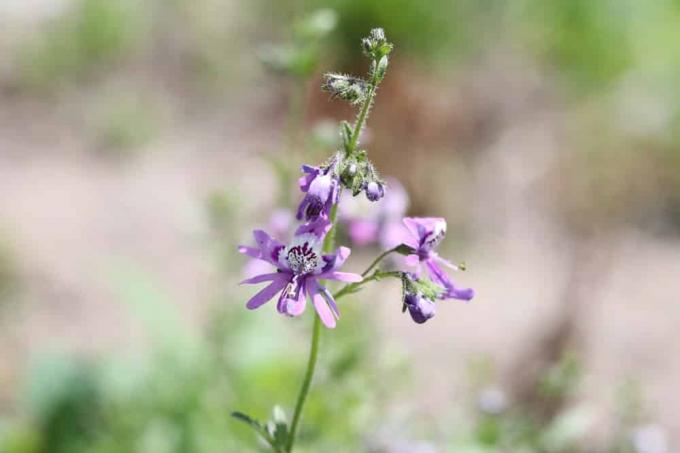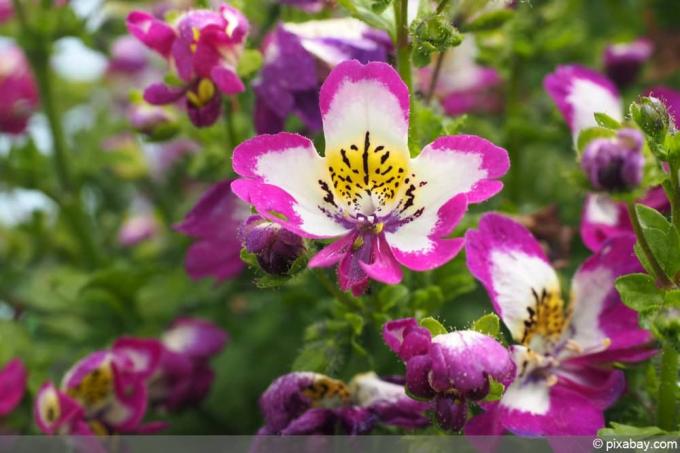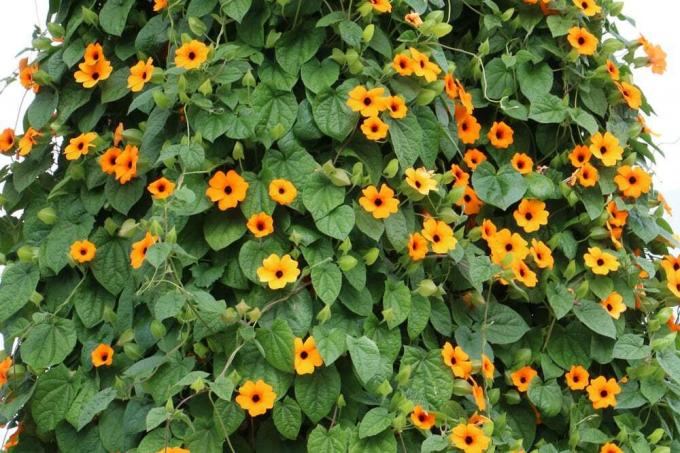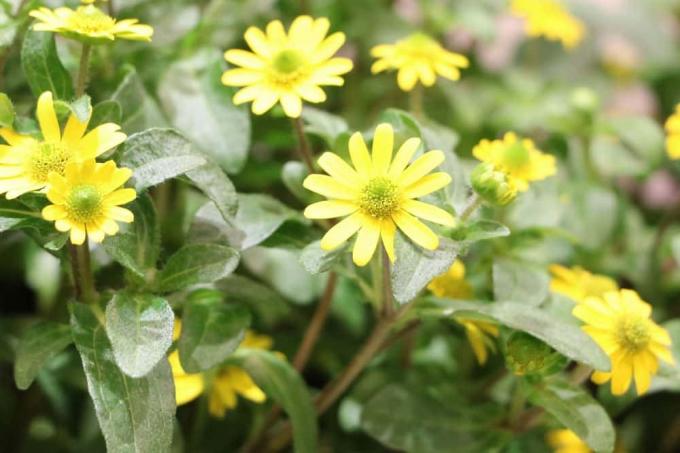

Table of contents
- Location
- substrate
- Plant
- Pour
- Fertilize
- waste
- tub culture
- hibernate
- multiply
- Caution: Toxic!
- Typical care mistakes, diseases and pests
The farmer's orchid is wild in its beauty, original and comparatively easy to care for - this has helped it to become very popular among hobby gardeners. As undemanding and versatile as the decorative plant is, care should still be coordinated. With the right knowledge, however, this is easily possible even for beginners in plant care.
Location
Partial shade to light sun and always protected - this is what the location for the farmer's orchid should look like. Waterlogging, such as locations with high groundwater or the proximity of bodies of water, do not tolerate the split flowers. Nor very windy places or depressions where cold air collects. Wind-protected places on the balcony or in the garden that are shaded by walls, fences or taller plants are ideal.
substrate
Farmer's orchids are not very picky about the substrate. The soil should be nutrient-rich and permeable, and not tend to compaction. The following are therefore well suited:
- Garden soil that has been enriched with mature compost or manure
- Pre-fertilized balcony potting soil
- Nutrient rich soil that has been loosened with sand, gravel or perlite
These requirements apply to both outdoor planting and pot culture.
Plant

When planting, you only have to pay attention to the temperature, because the farmer's orchid does not tolerate frost. It should therefore not be put into the bed too early. It is important when planting the Schizanthus that the location is selected appropriately and with the appropriate soil, fertilization or loosening addition is prepared and the time is right is chosen.
The split flower should not be in the bed before the last late frosts in May or June. In the tub, the nightshade plants are allowed to go outside from March or April - but only during the day. At night they have to be brought back into the house for protection.
Pour
The farmer's orchid has a high water requirement, especially during the flowering period. However, it does not tolerate waterlogging. Coordinated casting is therefore important, in which the following points are observed:
- Never allow the substrate to dry out completely, only allow it to dry superficially
- Avoid waterlogging, pay attention to good water drainage
- Do not water from above, leaves and flowers suffer from direct water contact
Tip:
During heavy rains in summer, the flowers often suffer and the plant as a whole looks ill. This is usually due to direct water contact alone and is nothing to worry about as long as the soil is permeable and drainage is assured.
Fertilize
What is a lush bloom for the viewer is a great effort for the farmer's orchid. This is only possible if the schizanthus has sufficient nutrients available.
Therefore, on the one hand, the substrate should be rich in nutrients and, on the other hand, it should be fertilized at least during the flowering period. A liquid fertilizer is given every two weeks.
Tip:
Mixing the liquid fertilizer with the irrigation water ensures an even distribution of the nutrients and prevents chemical burns on the roots.
waste
The farmer's orchid is not dependent on a trimming, but it benefits the flowering power and can stimulate the split flower to a second flowering phase. It is important:
- Remove wilted and dried flowers as soon as possible
- Cut right after the first flowering phase
- Shorten shoots by a third after flowering
- Use clean and sharp cutting tools
Tip:
If you immediately remove withered flowers and their shoots, you can gradually cut the farm orchid with them. This is gentler on the plant and continuously stimulates the formation of new flowers.
tub culture

The farmer's orchid can also be cultivated in a tub without any problems, but it requires appropriate care. The following factors are decisive for this:
- Loose, nutrient-rich soil
- Secured water drainage
- Pour "from below", i.e. directly onto the ground or into the saucer or planter
- Bring indoors at temperatures below 10°C
Especially the last point is an advantage. If the split flower has not been planted outdoors, it can easily be moved to a more sheltered location at low temperatures or even in continuous rain. To do this, however, more attention must be paid to ensuring that the water can drain off and fertilization usually has to be done more frequently.
hibernate
This is where opinions differ on the farmer's orchid. Some think that with the right overwintering, the Schizanthus can be cultivated for two years. The others think this is impossible. So it seems to be worth trying. It is known that the farmer's orchid is not frost hardy. This means that it cannot survive winters in temperate climates - even if they are mild. Nevertheless, it is possible to save the plant over the cold season or to provide a replacement in good time.
The first option is to bring the farmer's orchid indoors in late summer or early autumn and place it in a bright room where the temperature is between 10 and 18°C. Fertilization must be stopped. However, it should still be prevented that the substrate dries out completely. The second option is to get seeds from the farmer's orchid and thereby propagate and maintain them instead of overwintering them.
multiply
The farmer's orchid can be propagated by seeds. For this purpose, a few withered flowers are simply left on the Schizanthus so that seeds and fruiting bodies can form. These are removed in late summer or early fall and the seeds carefully removed from them. They are stored dry and dark over the winter.
The procedure described below is important and helpful for this:
- Between February and March the seeds can be sown in potting soil or the substrate described above and only lightly covered with it. Well moistened and placed in a light, warm place, they usually germinate within two weeks.
- For germination, the seeds of the farmer's orchid need a continuous supply of liquid and moisture. The easiest way to achieve this is to moisten the substrate and then cover the cultivation vessel with foil or a transparent pane. To avoid mold, the cover should be removed for a few minutes at least once a day. This allows excess humidity to escape and condensate to dry.
- Under optimal conditions, the seeds will begin to germinate after about two weeks.
- When the seedlings reach a height of five centimetres, you can separate and repot one to three plants per container.
- Fertilization can begin after eight weeks. As with germination and adult farmer's orchids, the water supply should be designed to prevent the substrate from drying out - but at the same time to prevent waterlogging.
Caution: Toxic!

Like many other nightshade plants, all parts of the farm orchid are poisonous. In households with small children or pets, the planting of the split flower should therefore be carefully considered.
Typical care mistakes, diseases and pests
Due to its toxicity, the farmer's orchid is very robust against pests, but can be susceptible to fungal diseases if not cared for. Substrate that tends to compact and waterlogging are the most common causes, while rot is a typical result.
If you make sure in advance that the culture conditions are right, you have already taken the best preventive measures. If such a disease has broken out, the removal of the affected parts of the plant can Transferring the plant to a fresh, well-drained substrate and using fungicides can help create. However, there is no guarantee that the farmer's orchid will be saved successfully.
 garden editorial
garden editorial I write about everything that interests me in my garden.
Learn more about annual plants

Datura in the garden: 6 information on reporting requirements and toxicity
Beautiful but very dangerous. We are talking about datura (datura), an annual and above all poisonous perennial with high potential for reproduction. The strikingly prickly, globular and walnut-sized fruits are eponymous. The flowers are very similar to those of the trumpet tree, which is also poisonous.

Annual and biennial herbs - 10 popular varieties
The right ingredient for the main course is still missing? The salad needs to be rounded off or refined? How practical if you can get the right herbs from your own garden! But when cultivating, the question often arises: Which varieties can be grown as annuals or perennials - and which ones taste best?

Annual plants: 10 beautiful perennials for the garden
Annual plants germinate, flower, and set seed, all within one growing season. Then they die off again, so that they are usually not frost hardy. However, the hardy seeds survive the cold season, so that annual plants sow themselves and come back the next year.

Annual summer flowers: comprehensive list sorted by colour
Annual summer flowers beautify every garden with their colorful blossoms. The development of these plants is limited to the growing season, they germinate and die in a year or during a season. Many of the annual summer flowers come from the tropics, so their seeds are very sensitive to cold.

Annual climbing plants: 15 fast-growing and flowering plants
Annual climbing plants offer the same thing: quick and lush greenery for impatient gardeners, natural privacy screen for cozy spots or just decorative leaves and many colorful ones Blossoms. They are easy to cultivate and, with their variety of varieties, provide new variety every year.

Hussar's Head, Sanvitalia – Care of Hussar's Head
The likeable hussar's head Sanvitalis procumbens blooms very persistently throughout the summer until the first frost. The garden, balcony and container plant is very easy to care for and constantly forms new buds. The blooms include all shades of yellow to orange flowers.
